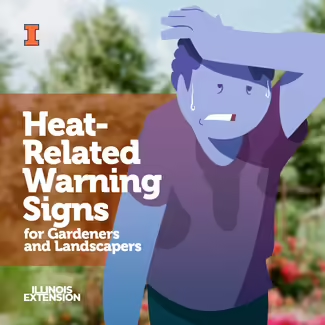
URBANA, Ill. — Landscaping and gardening are great physical exercises, and studies show they are good for emotional well-being. But those working outside must remain aware of the dangers associated with heat stress on their bodies.
“When I was working as a landscaper, we had to sod a large backyard during a day when the temperature was over 100 degrees Fahrenheit”, says Chris Enroth, Extension horticulture educator.
“We were hustling to get the sod down quickly, so it didn’t burn up in the hot sun. About midway through the day, I started feeling nauseated and dizzy, and I stopped sweating. I was disoriented and could no longer push my wheelbarrow. That’s when I knew I was suffering from severe heat exhaustion, perhaps even heat stroke,” says Enroth.
Hard work and warm weather can lead to dangerous health conditions. As muscles work, they generate heat. The warmer the air temperature is, the harder the body has to work to stay at normal body temperature.
When the body can’t keep up with maintaining its internal temperature, people experience heat exhaustion or, in more severe cases, heat stroke.
Heat exhaustion can take place over several days of working outside without proper rehydration. Symptoms include:
- Increased body temperature, above 100 degrees Fahrenheit.
- Cool, moist, clammy skin.
- Weakness and muscle cramps.
- Headache.
- Dizziness, nausea, or vomiting.
- Fainting.
Treat individuals experiencing symptoms of heat exhaustion by getting them to a cool place with good air movement where they can lie down with their legs elevated. Apply cold packs or wet towels while the individual drinks cold water. If symptoms do not improve after 30 minutes, seek medical attention.
Heat stroke is the most severe heat-related illness. Side effects can be as dangerous as organ failure, coma, or death. Symptoms of heat stroke are:
- High body temperature,106 degrees Fahrenheit or higher.
- Hot, dry skin — not sweaty. Red, flushed appearance.
- Rapid pulse and difficulty breathing.
- Confusion, hallucinations, or irrational behavior.
- Agitation, convulsions, or seizure.
If you suspect someone is having a heat stroke, dial 911 immediately.
“From my experience, most people suffering from heat stroke may not be aware of their condition until it’s too late,” says Enroth.
While waiting for emergency personnel, administer first aid to the individual by moving them to a cool place and removing excessive clothing. Allow them to rest while keeping their head and shoulders slightly elevated. Use any means to cool them by applying ice packs to the back of the neck, armpits, and groin area or putting them in a cool shower or bath. Monitor their body temperature as they cool, as it is possible to snap them into hypothermia. Once their body temperature reaches 102 degrees Fahrenheit, remove the ice packs and wet towels, or remove them from the bath or shower. Be vigilant for possible seizures.
Take Precautions
It doesn’t have to be 100 degrees outside for someone to experience heat stress. As winter warms to spring and summer, our bodies are not adapted to tolerate the heat. It takes one to two weeks to build up a tolerance for working in the heat. Landscapers and gardeners need to transition their bodies by initially scheduling shorter periods of work outside.
Enroth recommends hydrating before work begins. Take 15-minute breaks every two hours when working outside on a hot day. Consider scheduling the most strenuous activities during the morning or evening and avoid working during the hottest time of the day. Alcohol and drugs can increase the severity of heat stress, and so can some medications.
Sports drinks are good to have on hand, but water is the best thing to drink before, during, and after a hot workday.
Chris Enroth is an Illinois Extension horticulture educator for Henderson, Knox, McDonough, and Warren counties. Gardeners Corner is a quarterly newsletter from gardening experts around the state. Each issue highlights best practices that will make your houseplants, landscape, or garden shine in any season. Join the Gardener’s Corner email list at go.illinois.edu/GCsubscribe for direct access to timely tips.
PHOTO CAPTION: It doesn’t have to be 100 degrees outside for someone to experience heat stress. Landscapers, gardeners, and all need to transition their bodies by initially scheduling shorter periods of work outside and taking breaks in the shade. Photo: Adobe Stock.
Illinois Extension leads public outreach for University of Illinois by translating research into action plans that allow Illinois families, businesses, and community leaders to solve problems, make informed decisions, and adapt to changes and opportunities. Illinois Extension is part of the University of Illinois Urbana-Champaign College of Agricultural, Consumer and Environmental Sciences.

